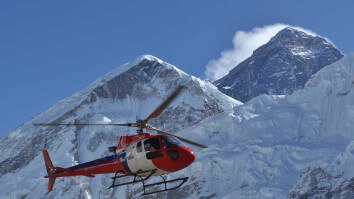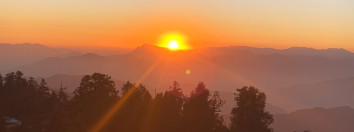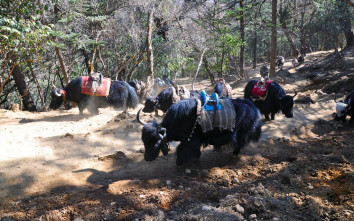Annapurna Base Camp Trek: Cost and Itinerary for the Adventure of a Lifetime
6th Jul, 2023
- himalayaheart

Introduction:
An experience that combines breathtaking natural beauty with an exhilarating adventure begins with the Annapurna Base Camp Trek. This journey, which is located in the Nepalese Himalayas, offers hikers the chance to experience spectacular mountain panoramas, small communities, and an array of landscapes. We will examine the cost and itinerary of the Annapurna Base Camp Trek to assist you in making plans for this amazing adventure and ensure you are prepared to have an unforgettable time.
Table of Contents

Annapurna Base Camp Trek Itinerary:
Depending on your speed and preferences, the Annapurna Base Camp Trek normally lasts 10–14 days. An comprehensive itinerary is provided below to give you an idea of what to anticipate:

Day 1: Upon arrival, be escorted to your hotel in Kathmandu. Spend today relaxing and adapting.
Day 2: Spend a day visiting Kathmandu's cultural and historical attractions such as the Boudhanath Stupa, Pashupatinath Temple, and Durbar Square, which are all included as UNESCO World Heritage Sites.
Day 3: From Kathmandu, catch a flight or a car to Pokhara, that acts as the gateway to the Annapurna region. Admire Pokhara's lovely beauty and unwind by the serene Phewa Lake.
Day 4: Travel from Pokhara to Nayapul by car and start your hike there. Trek to Tikhedhunga while passing through stunning forests, terraced crops, and tiny towns.
Day 5: To witness the stunning sunrise, make a journey from Tikhedhunga to Ghorepani and stop at Poon Hill. Soak in the vast panorama of the Dhaulagiri and Annapurna mountain ranges.
Day 6: Trek from Ghorepani to Tadapani while taking in views of Machhapuchhre (Fishtail Mountain) and exquisite rhododendron trees.
Day 7: Trek to the picturesque Gurung village of Chhomrong from Tadapani. Appreciate the breathtaking views of Hiunchuli and Annapurna South.
Day 8: Trek from Chhomrong to Bamboo, delighting in the peaceful landscape and passing the iconic Chhomrong Khola.
Day 9: Trek among lush vegetation and waterfalls from Bamboo to Deurali. Indulge in the amazing views of the Himalayas.
Day 10: The ultimate objective is to trek from Deurali to Annapurna Base Camp. Experience the stunning elegance of the mountains while feeling proud of yourself.
Day 11: Retracing your steps and admiring the sights as you hike from Annapurna Base Camp to Bamboo.
Day 12: Trek from Bamboo to Jhinu Danda to unwind in the area's thermal springs and revive your tired muscles.
Day 13: Drive back to Pokhara after a trek from Jhinu Danda to Nayapul. Celebrate your trek's completion while taking full advantage of Pokhara's comforts.
Day 14: Consider traveling to Kathmandu or prolonging your stay in Pokhara as you reflect back on the wonderful recollections you have built.
Cost Breakdown :
When planning for the Annapurna Base Camp Trek, it's essential to consider the costs involved. Here is a detailed breakdown of the major expenses:

Trekking Permits:
To undertake the Annapurna Base Camp Trek, you will need two permits:
TIMS Card (Trekkers' Information Management System):
All trekkers in Nepal are obliged to carry TIMS Cards, which act as a record of trekkers and include essential information for their security and safety. TIMS Card costs differ based on whether you are a foreigner or a member of the SAARC. The TIMS Card costs USD 20 per person per trip for Westerners and NPR 600 per person per trek for SAARC countries.
Annapurna Conservation Area Permit (ACAP):
You must obtain an ACAP permit because the Annapurna Base Camp Trek crosses the Annapurna Conservation Area. You are able to enter the conservation area due to the ACAP permit, which also helps to safeguard and uphold the land. The price of the ACAP permit varies for foreigners and SAARC nationals, similarly to the TIMS Card. The ACAP permit costs NPR 1,500 per person per trek for SAARC nationals, as opposed to USD 30 per person per trip for visitors.
Guide and Porters:
Your trekking experience can be greatly enhanced by partnering with a certified guide and porters. A guide enriches your understanding of the local culture, guarantees your safety, and offers insightful information. Depending on their experience and knowledge, guides can pay anywhere from USD 25 and USD 35 per day.
- You can hire porters to carry your backpack so you are able to focus on experiencing the hike rather than worrying about cumbersome loads. A porter normally costs between $15 and $25 per day to hire. The cost of a porter can be decreased by sharing one with other trekkers.
Accommodation and Meals:
There are tea houses along the trekking trail that offer simple food and lodging. The cost of accommodation varies according to the altitude and amenities offered. For a basic accommodation in a tea house, you should budget between USD 10 and USD 20 each night. Meals can range anywhere from $5 and $10 per serving. It's essential to remember that when you travel to higher elevations, the cost of lodging and food may rise as a result of the scarce resources.
Transportation:

You will need to set up transportation from Pokhara to the trek's starting point at Nayapul. A private car can be rented, or you can take a communal jeep excursion. Transportation from Pokhara to Nayapul will set you back between $30 and $50 per person.
Equipment and Gear:
If you are missing trekking supplies, you can rent or buy them in Pokhara or Kathmandu. Depending on the quality and length of the rental, equipment rentals for things like hiking boots, sleeping bags, jackets, and trekking poles can be expensive. Alternatively, you may purchase these things, but it's crucial to think about their weight and whether they'll be appropriate for the walk.
Miscellaneous Expenses:
It's a good idea to always have some extra money on hand for unexpected expenses like hot showers, charging electronics, bottled water, snacks, and tips for porters and guides. Additionally, you should budget for additional accommodation, food, and activities if you intend to stay longer in Kathmandu or Pokhara before or after the hike.
It's crucial to remember that the prices mentioned above are estimates and may change based on the time of year you trek, your specific preferences, the level of comfort you pick, and the duration of the trek. For a more precise cost estimate depending on your unique needs, it is recommended at all times to speak with experienced trekking entities or local guides.
Tips for Budgeting and Cost-Saving:
Although the Annapurna Base Camp Trek is an incredibly gratifying experience, it makes sense that you might wish to keep your costs low. Here are some suggestions to help you plan you’re spending and save money for your hike:

- Travel during the off-peak season: The summer shoulder seasons of March through May and September through November are good times to go hiking. You are often able to negotiate cheaper prices on accommodations, flights, and permits during these periods of time.
- Find hiking buddies or participate in group treks: It might be extremely affordable to hire a guide and porter together with additional trekkers. Another way to save costs is to take part in group treks that are arranged by trekking companies.
- Eat local meals: Consider traditional Nepalese cuisine over Western fare when dining at tea houses because it is typically less expensive. A popular and fulfilling option is dal bhat (rice and lentils).
- Carry a reusable water bottle: Carry a reusable water bottle and use water purification tablets or filters to guarantee safe drinking water rather than acquiring bottled water along with you.
- Book directly and avoid middlemen: Arrange direct reservations for your trekking permits and accommodation with approved companies or tea houses to avoid unwarranted costs.
Conclusion:
The Annapurna Base Camp Trek is a fantastic trip that offers incredible views, opportunities to interact with locals, and a sense of achievement. You can effectively manage your budget and ensure a smooth and pleasurable trekking experience by taking into account the advised itinerary and comprehending the associated costs. Keep in mind to conduct thorough studies, speak with experienced trekking organizations, and be prepared to endure the joys and hardships that await you on this historical trek across the Annapurna region. You can go on this once-in-a-lifetime adventure without going broke with meticulous preparation and some cost-saving measures. A happy trek!
Recent From Blog


























